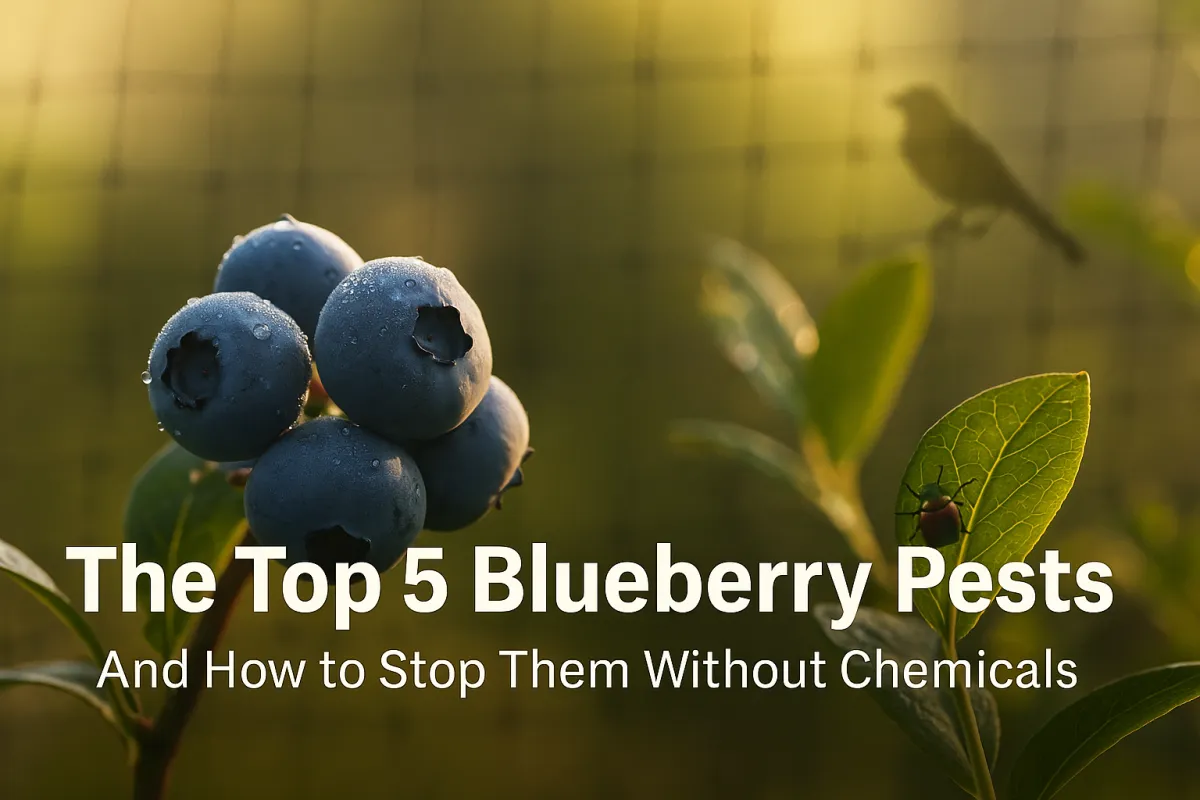
The Top 5 Blueberry Pests (and How to Stop Them Without Chemicals)
The Top 5 Blueberry Pests (and How to Stop Them Without Chemicals)
Intro: Lessons from the Berry Patch
I still remember the summer I thought I had blueberries figured out. The bushes were loaded, the leaves looked healthy, and I’d already told friends to stop by for a u-pick weekend. Then one morning, I noticed small dimples in the fruit and a few berries that seemed softer than they should be. Within days, the damage spread. By the time I realized I was dealing with more than just overripe fruit, half my crop was gone.
That season taught me a hard truth — blueberries may be tough little bushes, but their fruit is irresistible to a whole lineup of pests. The good news? You don’t need chemicals to win. You just need to know what you’re up against and act before the damage gets out of hand.
1. Blueberry Maggot
What It Is and How It Damages Crops
The blueberry maggot is a small fly whose larvae feed inside the berries, turning them soft and brown from the inside out.
Life Cycle and Timing of Attacks
Adults emerge in late June to mid-July in most USDA Zones 4–8, laying eggs directly into ripening berries.
Organic Prevention Methods
Remove and destroy any fallen or infested fruit.
Keep the area beneath bushes mowed to reduce hiding spots for emerging flies.
Trapping Strategies
Hang yellow sticky traps at berry height in early summer.
Use bait lures with ammonium acetate to improve capture rates.
2. Spotted Wing Drosophila (SWD)
Early Signs and Why They’re Dangerous
Unlike most fruit flies, SWD lays eggs in just-ripening fruit — not overripe fruit — so by the time you see them, damage is already happening.
How to Monitor for SWD
Set vinegar traps near your bushes and check daily.
Test suspect berries by placing them in saltwater — larvae will float to the top.
Organic Control Options
Prune for airflow to make the environment less attractive.
Use fine-mesh netting (1 mm or smaller).
Harvest fruit promptly and refrigerate immediately.
3. Aphids and Mites
How to Spot the Problem Early
Aphids: curling leaves, sticky residue (honeydew)
Mites: fine stippling or bronzing on leaves
Low-Impact Spray Options
Insecticidal soap for aphids
Neem oil for mites (apply in early morning or evening to avoid leaf burn)
Beneficial Insects That Help
Ladybugs for aphids
Predatory mites for problem mite populations
Lacewings for broad pest suppression
4. Birds
Which Birds Target Blueberries
Robins, starlings, and cedar waxwings will happily strip a bush in a day.
Effective Netting Techniques
Build a simple frame to hold the netting above the bush.
Anchor all edges so birds can’t sneak in from below.
Decoy Strategies That Work
Reflective tape or spinning pinwheels to deter swooping.
Predator silhouettes (hawks, owls) that you move every few days.
5. Japanese Beetles
How to Identify and Time Removal
Metallic green bodies with copper wings, most active from late June to August.
Hand-Picking Method
Go out in the early morning when they’re sluggish.
Drop them into a bucket of soapy water.
Natural Deterrents
Plant companions like garlic or chives nearby.
Apply milky spore powder to the soil to target grubs.
Introduce beneficial nematodes for long-term control.
Pro Tips: Keep Your Blueberries Safer All Season
Rotate deterrents so pests don’t get used to one method.
Keep bushes pruned for airflow and easy inspection.
Inspect fruit daily during ripening season — morning and evening if pests are active.
Grandma’s Tip
"You can’t fight what you can’t see — check your berries before the pests do."
Region-Specific Notes (USDA Zones 4–8)
Zones 4–5: Blueberry maggot and SWD activity starts later (mid-July).
Zones 6–8: Earlier pest pressure; netting and traps should be in place by late June.
Japanese beetles can appear earlier in southern zones — watch soil temps in spring.
Faith Tie-In
The Bible tells us, "Be diligent to know the state of your flocks, and attend to your herds" (Proverbs 27:23). Tending the harvest — and guarding it from pests — is part of faithful stewardship.
Closing Action Step
Don’t wait until you see damage. Walk your berry patch today, spot-check for early pest signs, and put prevention in place. Download the Printable Blueberry Pest ID & Prevention Checklist so you can take it with you into the garden.


Facebook
Instagram
X
Youtube